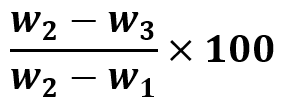Aim: To determine Moisture Content and Loss on Drying from a given solid sample
Requirements:
Chemicals: Sample (Calcium carbonate)
Apparatus/ Instruments: Hot air oven, analytical balance, glass crucibles, Petri dish, tongs.
Loss of drying principle
Loss on drying is a widely used test method to determine the moisture content of a sample, although occasionally it may refer to the loss of any volatile matter from the sample. Loss in drying does not usually refer to molecularly bound water or water of crystallization. The temperature at which you should expose the substance to be tested is always specified and must not be exceeded or you get the wrong results. Every substance has its specific heat level. Loss on drying testing in pharmaceuticals is a technique of removing water and other volatile impurities from a sample of a well-mixed substance. The amount of heat applied to the substance is dependent on time and temperature. The total moisture content of pharmaceutical products can contain both bound and free water. Where there are impurities present then loss on drying level will be higher as compared to water content.
The rate of drying is determined by moisture content and the temperature of the compound and the temperature, the humidity (relative), and the velocity of the air in contact with the compound. Equilibrium moisture content (EMC)is the amount of water present in a solid, which exerts vapor pressure equal to the vapor pressure of the atmosphere surrounding it. When air is continuously passed over the solid containing moisture more than EMC, then the solid adsorbs water continuously till EMC is reached. This phenomenon is known as sorption. From these observations, it is clear that material can be dried up to EMC, but not below it.
There are two basic mechanisms involved in the drying process viz. the migration of moisture from the interior of an individual compound to the surface, and the evaporation of moisture from the surface to surrounding air the value of EMC depends on the material and relative humidity and temperature of the air with which it is in contact. The speed with which it is approached depends on the properties of the material the surface-area-to-volume ratio of its shape, and the speed with which humidity is carried away or towards the material (e.g. diffusion in stagnant air or convection in moving air)
The important factor affecting the rate of drying are :
- The initial moisture content of the raw material.
- Composition of raw material.
- The initial load of the feed is kept in a drier.
- Size, shape, and arrangement of stacking of the raw material.
- Temperature, relative humidity, and velocity of air used for drying.
- Rate of heat transfer on the surface of the food.
- Pre-treatment of the raw material prior to drying (peeling, blanching, etc)
- During the drying process, the control of air temperature and its circulation in the system is important.
The procedure involved in Loss of Drying
A] Determination of moisture Content
- 5 gm of the sample (chalk powder/starch/talc)is accurately weighed.
- The sample is transferred into an empty crucible and weight is recorded.
- The crucible containing the sample is placed into a hot air oven at 600C and its weight is recorded aGer each 10-minute interval for a period of 1 hour.
- Moisture content and % moisture content are calculated.
B] Determination of Loss on drying
- 5 gm of the sample (chalk powder/starch/talc)is accurately weighed.
- The sample is transferred into the previously weighed empty crucible and its weight is recorded along with the sample.
- The crucible containing the sample is placed into a hot air oven at 1000C for a period of 1 hour.
- A Ger one hour of heating again the weight of the crucible is recorded.
- Loss in weight of the sample has calculated a Ger 60 minutes of heating.
- % LOD is calculated.
Observations:
A] Determination of moisture Content
Weight of sample powder=W=
Weight of empty crucible =W1=
Weight of crucible with sample =W2=
The temperature of the oven =
Observation table:
| Time (min) | Weight of crucible with powder a†er drying W3 (gm) | Moisture content  | % Moisture content  |
| 0 | |||
| 10 | |||
| 20 | |||
| 30 | |||
| 40 | |||
| 50 | |||
| 60 |
B] Determination of Loss drying
Weight of sample powder =W1=
Weight of empty crucible =W2=
Weight of crucible with sample before drying=W3=
Weight of crucible with sample aGer drying of 60 minutes =W4=
Weight of sample ager drying of 60 minutes =W5= W4 –W2
The temperature of the oven =
Observation Table:
| Sr. No. | Sample | Weight of powder after 1 hour of drying |
Calculations:

Results & Discussion:
- The % Moisture content of the sample was found to be
- % Loss on drying of the sample was found to be
Make sure you also check our other amazing Article on: Scraped Surface Heat Exchanger
